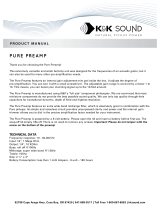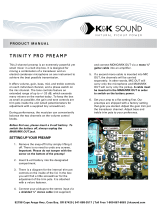Page is loading ...

1
EHRLUND
ACOUSTIC PICKUP
+ PREAMPLIFIER
MANUAL | ENG

CONTENTS
QUICKSTART ................................ 3
PICKUP .......................................... 5
Attaching the pickup .................... 6
PREAMP ......................................... 9
Features Preamp .........................10
Phase switching ..........................10
Operation High/Low ...................11
Volume control ............................. 11
Replacing the battery ................. 12
THINGS TO BEAR IN MIND ..14
The pickup is connected to the preamp at the IN-
PUT jack socket. The mixer/amplifier is connected
to the OUTPUT jack socket. Note that the preamp
automatically switches on when a connection is
made in the OUTPUT jack socket.

3
A cleaner sound.
1. Fix the pickup to the instrument using the adhesive supplied.
Shape the adhesive into small balls about 3-4 mm in diameter
and attach these to the corners of the pickup. Then stick the
pickup down where you want it on the instrument. For more infor-
mation, see page 6.
2. Connect the pickup to the input on the preamp.
3. Connect the output from the preamp to the amplifier/mixer.
4. The volume control on the preamp is normally set to maximum.
The volume is usually controlled by the connected amplifier/mixer.
5. If you think the sound is strange, for example due to feedback,
this may mean that the phase switch needs to be changed.
6. You may need to adjust the High/Low switch, depending on
the gain at subsequent stages. For example, if you feel that the
sound is clipped, you can try setting this switch to “Low”.
7. When the preamp is not in use, disconnect the cable between
the preamp and the mixer/amplifier. The “output” jack acts as the
switch to turn the preamp on and off. When you connect a cable
to “Output”, the preamp switches on automatically.
EAP SYSTEM QUICKSTART

4
TECHNICAL SPECIFICATIONS PICKUP
Length
28 mm
Width
25 mm
Height
5 mm
Weight
4 g
Length of cable
150 cm
Weight with cable and connector
42 g

5
THE EHRLUND ACOUSTIC PICKUP (EAP) is an ultra-linear con-
tact microphone for instruments with an acoustic sound box, such
as the guitar, violin, double bass and ethnic instruments. It is made
entirely in Sweden and is based on the same knowledge of sound
recording as Ehrlund’s other products.
A linear microphone means that the pickup reproduces a flat
frequency response. The pickup captures the vibrations of the
acoustic instrument, enabling the microphone to provide excel-
lent separation, even in what are normally “impossible” conditions,
where musicians playing together generate high noise levels on
their respective instruments. In testing, very good results were
achieved, for example, in mismatched combinations, such as heavy
metal music and the cello.
The EAP is sold separately or in a set, EAP SYSTEM, together
with the PREAMP.
EHRLUND ACOUSTIC PICKUP

6
ATTACHING THE PICKUP
The EAP can be moved easily between different instruments. The pickup
is easy to attach using adhesive on the sound box. The pickup can also
be attached to the inside of the instrument via the sound hole.
Each instrument is unique, which is why the positioning of the pickup
needs to be tested in advance. The first time you do this, it can take some
time before you find the best position. We know from experience that it is
worth the time it takes to find the ideal position for the pickup, so that the
people in front of you get a musical experience that is the same as if you
were playing without amplification. Some musicians have made a card-
board template to fit against part of the instrument, which makes it easier
to attach the pickup in the same place for every performance.
Some examples of positions that usually work really well.

7
The adhesive needs to be shaped into small balls about 3-4 mm in dia-
meter and attached to the corners of the pickup. Never attach adhesive
to the middle of the pickup. Then stick the pickup down carefully on the
instrument so that there is about 2 mm of space between the pickup
and the instrument.
The adhesive used to attach the pickup is sometimes queried.
However, violinists who have been using the pickup for many years say
that they cannot see any marks on their instruments. Use only the white
adhesive that is supplied with the pickup. Other types of grey or green
adhesive may leave marks. The recommended adhesive is Faber-Castell
TACK-IT White, art. no. 18 70 91-60.
The adhesive needs to be shaped into small balls about 3-4 mm in diameter and attached
to the corners of the pickup. Important: Never attach adhesive to the middle of the pickup.

8
TECHNICAL SPECIFICATIONS PREAMP
Length
92 mm
Width
60 mm
Height
37 mm
Weight
150 g
Battery
9V/6LR61/6LF22/MN1604
Power consumption
0,5 mA
Minimum supply voltage
7,2 V

9
THE EHRLUND PREAMP has extremely low self-noise and low
power consumption. It is optimised for use with the Ehrlund EAP
pickup. It is able to operate with most existing accessories, such as
foot pedals, effects pedals and transformer-equipped DI boxes.
The preamp is fitted with a belt clip and can easily be attached to
the waistband. It is powered by a 9 V battery, has a long operating
time of at least 600 hours and switches off when the output cable is
disconnected.
The preamp can be adjusted for volume control, basic amplification
and phase adjustment to avoid feedback during live performance.
Like other Ehrlund products, the preamp is developed and manu-
factured in Sweden.
EHRLUND PREAMPLIFIER

10
FEATURES PREAMP
Input
6,3 mm tele jack
Output
6,3 mm tele jack. The Preamp turns itself off when the
output cable is disconnected.
Phase switch
The unit has a phase switch (0-180°) which is used to
avoid feedback during live performance.
High/Low
The unit can be adjusted for high/low input from the
microphone.
PHASE SWITCHING
It should also be remembered that the switch for phase can make
a big difference, because the speaker can work with or against the
instrument’s sound box. Use the switch to get the best possible
sound. This is particularly useful to bear in mind when playing at
high volume in small venues.
If the sound is “tinny”, you can try to move the switch to its other
position.

11
OPERATION HIGH/LOW
VOLUME CONTROL
The High/Low switch is used when you find a point on the instrument
where you get a good, strong signal. The place where the sound is
loudest is not normally the point on the instrument where you get the
best sound. The switch determines only the internal gain of the preamp;
it has no other effect on the sound.
There have been occasions when a musician has done a sound check
with the switch in the High position and everything has sounded good.
During the recording, the musician has then played so loud that the
preamp saturated, and the sound gets distorted due to clipping. When
the switch was then set to the Low position, everything sounded good
again. This is something you just have to experiment with.
The Preamp has a fairly low output. The volume control is usually set
to maximum output, and is only used if, for some reason, you want to
limit the output. The output is sufficient for all standard line inputs on
the mixing board. If you try to connect the preamp directly to a power
amplifier, the input may be too low to operate the amplifier.

12
REPLACING THE BATTERY
1. Remove the two nuts on the INPUT/OUTPUT side.
2. Unscrew the two screws on the volume control side.
3. Place your fingers on Input and Output and press.

13
4. The Preamp will open on the volume control side. Carefully pull away
the cover until you reach the battery. You can now replace the battery.
5. If you pull the entire circuit board from the case, it is important that
the card is replaced in the correct slots in the case.

14
THINGS TO BEAR IN MIND
• Cable microphonics are one of the drawbacks of the pickup system,
regardless of brand. These microphonics are a mechanical property
of the cable. If you set the cable in motion, for example by hitting it
or through other strong movement, you induce mechanical waves,
which propagate through the cable to the pickup. As the pickup is a
microphone that is sensitive to mechanical vibrations, this wave will be
converted to an electrical signal that interferes with what you want to
hear. To counteract this, you can make a loop (30-50 mm diameter) on
the cable, as close to the pickup as possible. Then attach the cable
using a soft material where it leaves the instrument.
• A straight cable will always generate more noise than a coiled cable.
You can easily check this by pinching the cable between your thumb
and forefinger and then sliding your fingers along the cable. Try it on
both a straight cable and a coiled cable and see the difference.
• Some musicians t a contact and connect the pickup directly to a
mixer or other device. It is possible to do this, but the result may not be
as good because the components have different impedances.

15
For warranty details see www.ehrlund.se
If you have any questions, tips or comments, please contact [email protected]
Connect the pickup to a preamp with a high impedance input. The
EAP is designed to work optimally with the EHRLUND PREAMP.
• Placing a pickup on an instrument makes the entire system act as
a microphone. This means that the pickup may also capture other
vibrations, such as sound from other instruments and from loud-
speakers. The sensitivity to these sounds will be significantly lower,
however, than with a normal microphone. The sound from strikes and
impacts on your own instrument will also be captured by the EAP.
Handle your instrument carefully.
• If you connect the EAP to a preamp from another manufacturer,
you may get unexpected effects, because other pre-amplifiers often
contain fixed filters to improve the frequency response from a certain
pickup. The Ehrlund Preamp does not have any filters; it is a pure
low-noise amplifier.
• The preamp can also be used for electric guitars. In this case
connect it directly to the mixing board.

16
www.ehrlund.se
A cleaner sound.
The very best music experiences have something in common.
Be it a warm guitar, a jazzy voice, a tingling piano piece, total
presence. Every nuance becomes suddenly important. You
listen, experience, and want to stay in the moment.
A triangular membrane is the secret behind the clean
sound of an Ehrlund Microphone. The technology is based
on knowledge of the properties of sound that dates back
thousands of years. Just as a circular shape gives sound
resonance, a triangle muffles resonances fast. An association
that no microphone company before us has picked up on.
The end result is a sound almost free from background
noise and disturbing resonances. A sound where even the
tiniest of nuances of voice and instrument can come through.
This creates a music experience that feels incredibly
intimate, tight and genuine. Music that gets under your skin.
The way music is supposed to sound.
/



